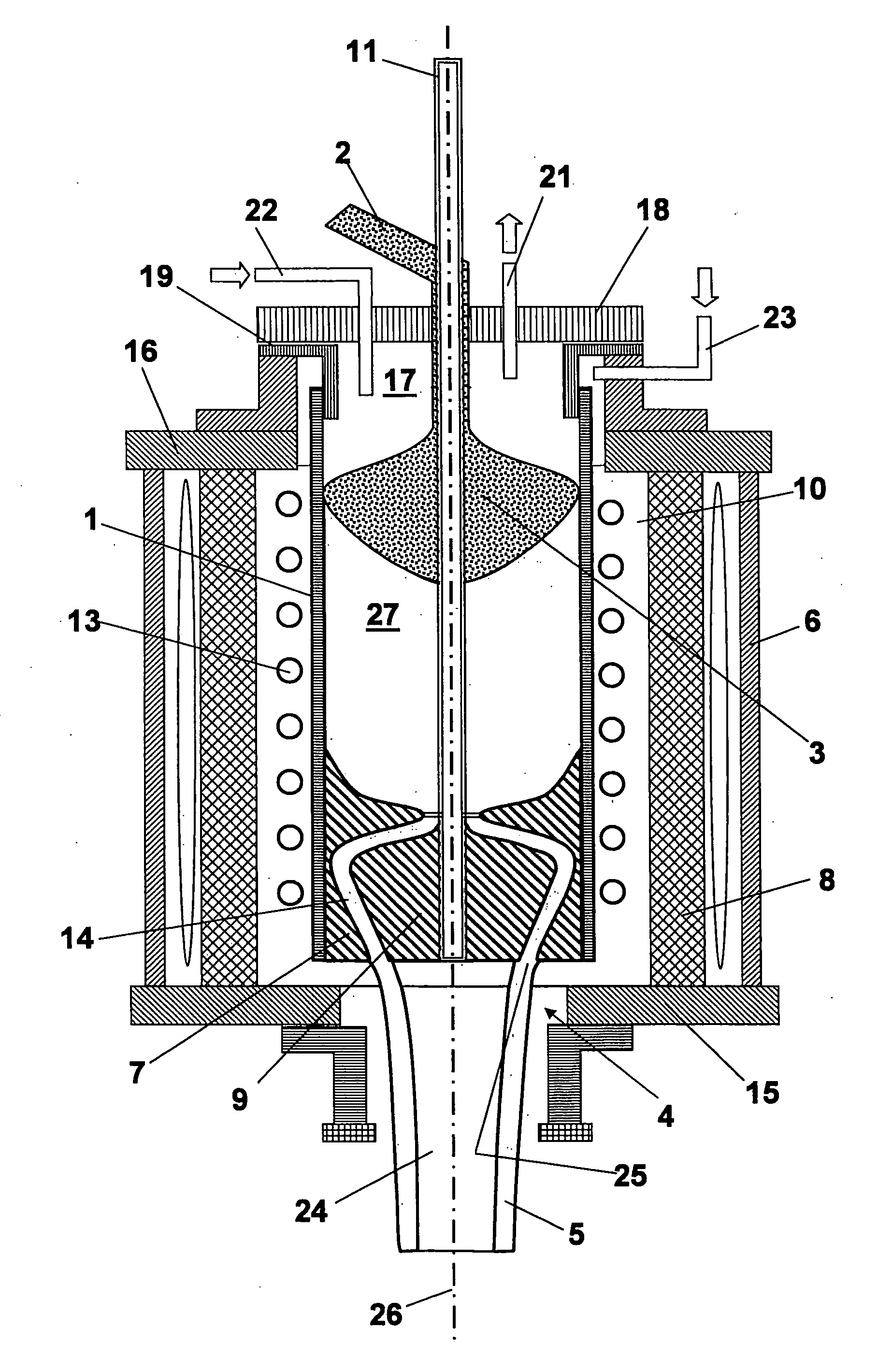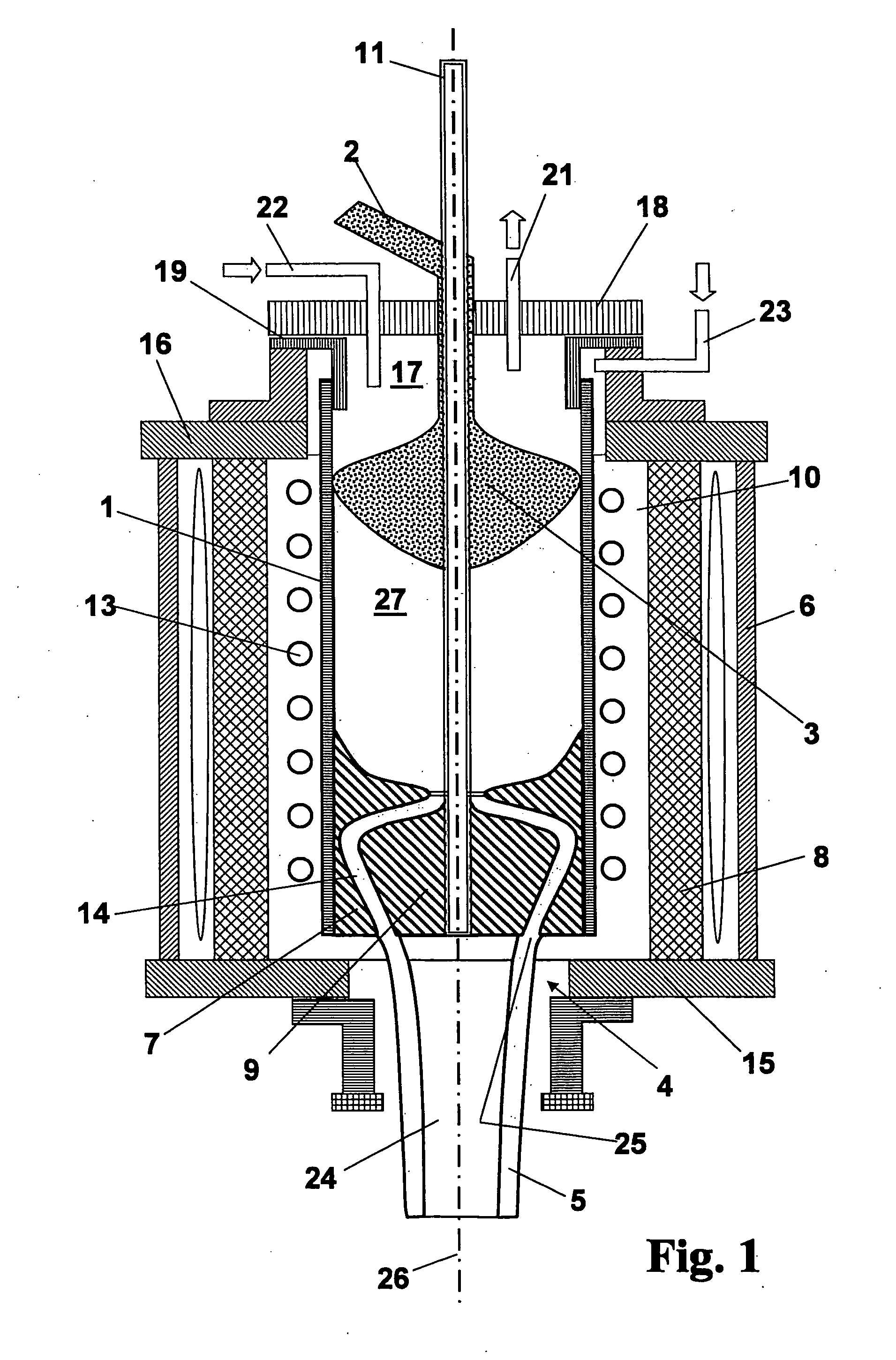Method for producing quartz glass doped with nitrogen and quartz glass grains suitable for carrying out the method
a technology of nitrogen and quartz glass, which is applied in the field of producing quartz glass doped with nitrogen and quartz glass grains suitable for carrying out the method, can solve the problems of nitrogen doping, plastic deformation of quartz glass components, and thermal stability of quartz glass here a limiting factor
- Summary
- Abstract
- Description
- Claims
- Application Information
AI Technical Summary
Benefits of technology
Problems solved by technology
Method used
Image
Examples
embodiment
[0081]The invention will now be described in detail with reference to an embodiment and a patent drawing. Shown is in detail in
[0082]FIG. 1 a crucible melting device for drawing a strand of quartz glass according to the invention in a schematic illustration;
[0083]FIG. 2 a melting device for producing a crucible of quartz glass according to the invention in a schematic illustration;
[0084]FIG. 3 a diagram with the viscosity progress over temperature in the case of a quartz glass according to the invention as compared with a quartz glass according to the prior art; and
[0085]FIG. 4 the result of a hot gas extraction of a quartz glass according to the invention in the form of a diagram in which the outgassing volume is plotted versus the heating-up period (temperature).
example 1
Production of Quartz Glass with Oxygen Defects
[0086]SiO2 soot bodies are produced by flame hydrolysis of SiCl4 on the basis of the known OVD method. The nanoscale amorphous SiO2 particles (soot dust) obtained thereby as filter dust are processed by means of a standard granulation method into a porous SiO2 granulate. After the drying process the SiO2 granulate is heated up in a heating furnace with a heating element of graphite to a temperature of about 850° C. and is pre-compacted. The graphite existing in the heating furnace causes the setting of reducing conditions. After a treatment duration of four hours a porous SiO2 granulate is obtained.
[0087]The granulate is vitrified under vacuum at a temperature of about 1,300° C. This yields high-purity quartz glass grains of amorphous, spherical SiO2 particles having a mean particle diameter of about 200 μm, which are distinguished by a hydroxyl group content of about 25 wt. ppm and a concentration of oxygen defect centers in the order o...
example 2
Loading the Porous SiO2 Granulate with Nitrogen Prior to Vitrification
[0088]The oxygen defect-containing porous SiO2 granulate produced in this way is subjected to an oxidative-thermal doping treatment and loaded with nitrogen. To this end a loose granulate is treated in a two-stage process first at a temperature of 450° C. for a period of 1 hour in a gas stream of N2O (10 vol.-%), the balance being helium. This temperature is below the decomposition temperature of N2O, which is evenly distributed in the loose granulate. In the second treatment phase the loose material is heated up to a temperature of 800° C. and the gas stream is replaced by a quiescent atmosphere of N2O (10 vol. %), the balance being helium. The uniformly distributed N2O decomposes with formation of atomic nitrogen and atomic oxygen. Some of the oxygen deficiency sites of the quartz glass are occupied by atomic nitrogen, which leads to the formation of Si—N bonds and thus to a chemical incorporation of nitrogen in...
PUM
| Property | Measurement | Unit |
|---|---|---|
| mean particle size | aaaaa | aaaaa |
| mean particle size | aaaaa | aaaaa |
| treatment temperature | aaaaa | aaaaa |
Abstract
Description
Claims
Application Information
 Login to View More
Login to View More - R&D
- Intellectual Property
- Life Sciences
- Materials
- Tech Scout
- Unparalleled Data Quality
- Higher Quality Content
- 60% Fewer Hallucinations
Browse by: Latest US Patents, China's latest patents, Technical Efficacy Thesaurus, Application Domain, Technology Topic, Popular Technical Reports.
© 2025 PatSnap. All rights reserved.Legal|Privacy policy|Modern Slavery Act Transparency Statement|Sitemap|About US| Contact US: help@patsnap.com



